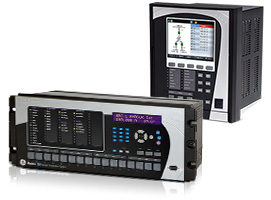Essential transformer diagnostics for comprehensive protection
Optimize your capital expenditure, increase the life of your transformer, and improve reliably of service by implementing a preventative asset maintenance & management tool using the Multilin T60, T35 and 845 transformer protective relays
Essential transformer diagnostics for comprehensive protection
Optimize your capital expenditure, increase the life of your transformer, and improve reliably of service by implementing a preventative asset maintenance & management tool using the Multilin T60, T35 and 845 transformer protective relays

Transformer Protection Systems
Delivering fast, adaptive, sensitive and secure protection for small, medium and large power transformer applications. Multilin protection relays include advanced Health Diagnostics capabilities, coupled with advanced communications including IEC 61850 for remote data and engineering access to increase asset life and improve quality of service.
Top Oil Temperature
- Improve maintenance through oil temperature monitoring
- Detection of oil aging to avoid isolation faults
- Monitoring and alarming easily integrated with SCADA systems
Winding Hot Spots
- Advanced algorithm based on IEEE C57.91-1995 and C57.96-1989
- Constant, value-based monitoring of winding temperatures
- FlexLogic for control of cooling fans
Internal Short Circuit
- Fast tripping with unrestrained differential element
- Enhanced selectivity with double break point transition characteristic
- Sensitive ground current differential element

Increased equipment use, deferred capital expenditures and reduced maintenance expenses are challenges faced by most capital asset owners today. Therefore, managing critical electrical system assets such as large power transformers require a preventative maintenance plan that can screen device degradation and make intelligent device protection decisions.
Excessive heat and mechanical stress are major reasons for transformer damage. These factors can cause hot spots, breakdown of winding insulation, short circuits, and catastrophic failures. The good news, however, is that transformer failures are attributable to manageable problems and new technology in transformer protective relays enable Engineers to implement a diagnostic approach to assess the health of power transformers.
Measurable indicators of transformer health include electrical load, hottest-spot, ambient temperature, loss of life etc. Users who use protective relays to monitor these indicators, plan optimal transformer loading and maintenance, and thereby increase life of their asset and improve quality of their service.
The transformer top-oil temperature can be directly measured, or calculated from the ambient temperature, load current, and other transformer characteristics. The protective relays can be set to alarm or trip in cases where the computed hottest-spot temperature is above the pickup threshold for a user specified time (considered as transformer overheating).
Multilin relays use IEEE C57.91 compliant thermal models to calculate the winding hot-spot temperature, detect abnormal temperatures inside the transformer, and prevent loss of life of the winding insulation. The loss of life element detects the accumulated total consumed transformer life. This element can be set to issue an alarm or trip when the actual accumulated transformer life becomes larger than the user-specified loss of life pick up value.
The protective relay aging element detects the transformer aging in per unit normal insulation aging. This element can be set for alarm or trip whenever the computed aging factor is greater than the maximum permissible user-defined pickup setting under emergency loading conditions and maximum ambient temperature.
